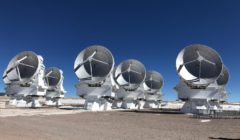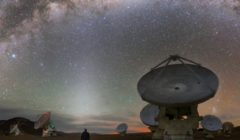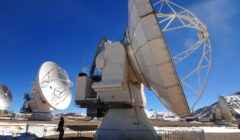- ALMA observatory
- The Milky Way as seen from ALMA in Chile.
- satellites at ALMA
Thanks to the clarity of its sky – with more than 300 clear nights a year and very low light pollution, Chile (especially the Atacama Desert) has become the most important location in the world for astronomical observations. Chile is becoming more and more specialised in this field of science and the astrotourism offers are constantly being expanded.
The radio telescope observatory ALMA (Atacama Large Millimeter/Submillimeter Array) was built in 2004 and is an international astronomical facility in the Atacama Desert. The dry area of the Chajnantor Plateau in the northern Chilean Andes offers ideal conditions for ALMA’s operation and thus became home to the largest telescope in the world. Its 66 antennas with a diameter of approximately 12 m each are distributed over a distance of up to 16 km and provide astronomical data and images of the highest quality. Here the invisible is made visible; the formation of stars and planets is explored, and the astronomers’ knowledge of celestial objects and phenomena is made available to humanity. ALMA also houses one of the world’s most powerful “supercomputers”. Plus, the giant telescopes can receive radio waves from the universe 24 hours a day and not just the images visible at night, allowing the observatory to observe space around the clock.
During the day, ALMA opens its doors to visitors to give them an understanding of astronomy. In the Operations Centre (OSF) located 2900 m above sea level, visitors can immerse themselves in the world of ALMA’s staff and follow the work of an astronomer in the control room. The facility on the Chajnantor plateau (at an altitude of 5000 m) is not accessible to tourists.
If you are interested in an astronomy tour, please contact your travelArt representative or send an email to info@travelart.com.




